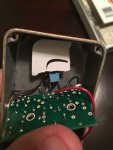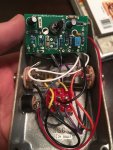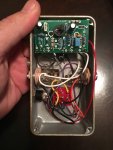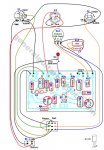pikingrin
what is this?
Probably stupid, I can't find an specific yea or nay on it though...
Before thanksgiving I put together a treble boost kit from GGG and, upon plugging it in and powering it up, when the pedal was bypassed there was a signal to the amp. When the pedal was engaged the no signal passed through. I've been in and out of town since then and have just started to troubleshoot - building my audio probe tonight or tomorrow morning so that's in the works.
Tracing through the "schematic" that I got from GGG, it appears that all of my connections are made in the right places, soldering is shiny and clean (much better looking than the first pedal I built that actually works) and I'm running out of ways to check what's wrong (until audio probe is complete).
All that being said... One thing that I did on both builds was forego the battery terminal installation between the input jack sleeve terminal and the DC power supply jack terminal. My brain says since pedal 1 worked without it then pedal 2 should as well but I'm trying to double check my reasoning - I'm human and I've been wrong in my assumptions before... Is that an accurate assumption in this case though?
Before thanksgiving I put together a treble boost kit from GGG and, upon plugging it in and powering it up, when the pedal was bypassed there was a signal to the amp. When the pedal was engaged the no signal passed through. I've been in and out of town since then and have just started to troubleshoot - building my audio probe tonight or tomorrow morning so that's in the works.
Tracing through the "schematic" that I got from GGG, it appears that all of my connections are made in the right places, soldering is shiny and clean (much better looking than the first pedal I built that actually works) and I'm running out of ways to check what's wrong (until audio probe is complete).
All that being said... One thing that I did on both builds was forego the battery terminal installation between the input jack sleeve terminal and the DC power supply jack terminal. My brain says since pedal 1 worked without it then pedal 2 should as well but I'm trying to double check my reasoning - I'm human and I've been wrong in my assumptions before... Is that an accurate assumption in this case though?










